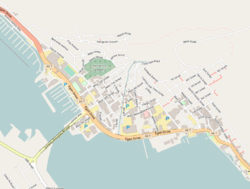| Bergmann Hotel | |
|---|---|
 The Bergmann Hotel, seen here in better times, on May 11, 2011 | |
 | |
| General information | |
| Location | 434 3rd Street, Juneau, Alaska |
| Coordinates | 58°18′10″N134°24′22″W / 58.30278°N 134.40611°W |
| Opening | December 16, 1913 |
| Closed | March 10, 2017 |
| Technical details | |
| Floor count | 3 |
| Other information | |
| Number of rooms | 42 |
| Number of suites | 0 |
| Number of restaurants | 1 (closed) |
Bergmann Hotel | |
| Location | 434 3rd Street, Juneau, Alaska |
| Coordinates | 58°18′10″N134°24′22″W / 58.30278°N 134.40611°W |
| Area | less than one acre |
| Built | 1913 |
| Built by | Marie E. Bergmann |
| NRHP reference No. | 77000217 [1] |
| AHRS No. | JUN-018 |
| Significant dates | |
| Added to NRHP | July 28, 1977 |
| Designated AHRS | 1975 |
The Bergmann Hotel is a historic hotel located at 434 3rd Street in Juneau, Alaska. It is listed on the National Register of Historic Places.



